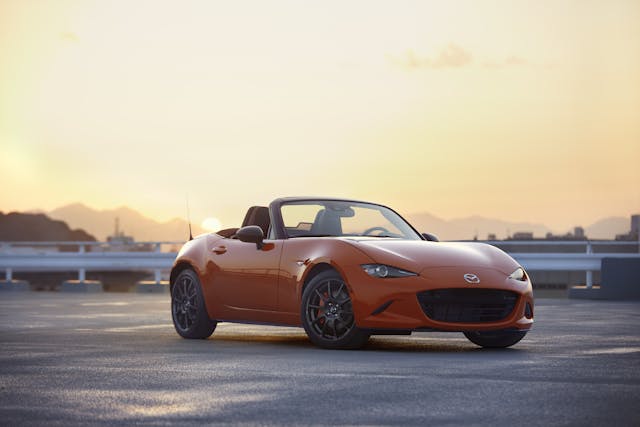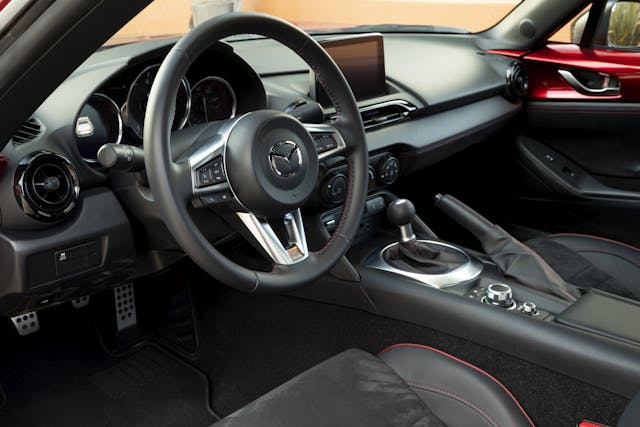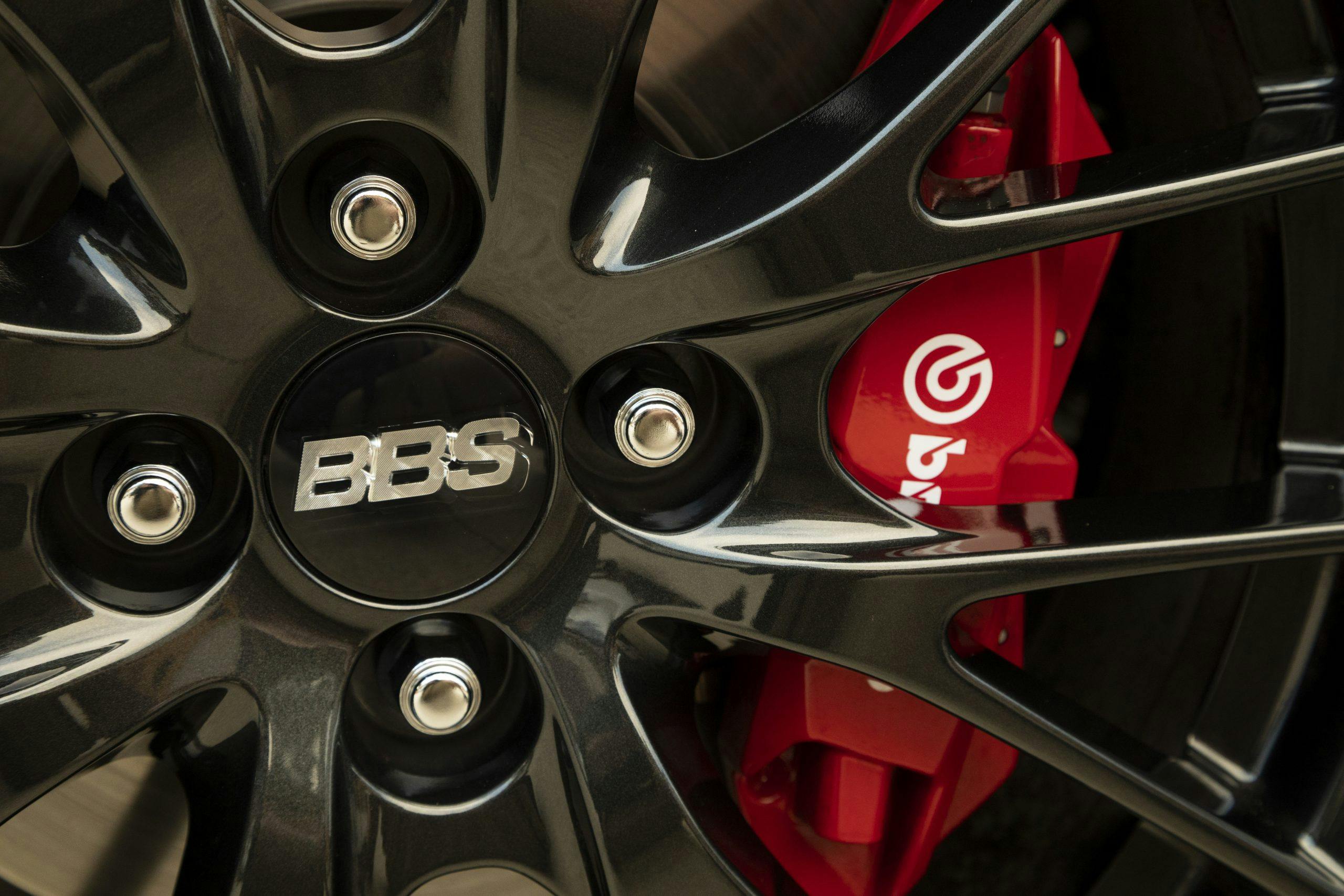The modern Mazda MX-5: Base Is Ace
If you’re considering a new Mazda roadster, there are four MX-5s to choose from, and the first two don’t count.
In order of importance and desirability to this driver are the $80,000 MX-5 Cup race car—which will cost a few more bills than that if you wish to compete in the IMSA Mazda MX-5 Cup championship—and Flyin’ Miata’s LS3-powered ND conversion. At the time I drove the latter, it cost $50,000 in addition to your complete, untarnished donor Mazda.
As much as I appreciate the idea of a Miata coupe, the RF doesn’t tickle my fancy or any other part of me. The RF driving experience is spoiled by impolite amounts of wind noise generated by airflow crashing into the roof’s buttress. The classic argument against the RF is that the roof panels and associated mechanisms sit far too high in the chassis, an arrangement which spoils this carefully engineered roadster’s center of gravity. I don’t necessarily disagree, though I’d contend that a driver’s job is to make the most of whatever car they are piloting; but, given the choice between an RF and a roadster, I’d always choose the soft top. Perhaps I’d simply enjoy a fixed-roof Miata, but there’s not a future in which we’ll experience that.

Today’s fourth generation (ND in Miata-nerd parlance) is six model years into its run and the 2019 update resulted in what I think is the perfect modern roadster. These post-2018 MX-5s have been dubbed ND2s and are the most desirable factory-built Miatas to date.

The engine is the heart of that update and, while it now makes more power than the pre-2019 cars, the engineers didn’t make any radical changes, taking instead a subtle and careful approach. They massaged the cylinder head and lightened the block’s internals, resulting in a bump of 26 horsepower to a new peak of 181 horses produced at 7000 rpm. Torque was bumped up by just 3 lb-ft and the rev limit raised from 6800 to 7500 rpm.
When the ND2 was introduced, I rang up Keith Tanner of Flyin’ Miata for some insight because I correctly assumed they’d already put the refreshed MX-5 on their dynamometer. Between ND1 and ND2 two-litre engines, power and torque curves are nearly identical under 6000 rpm. The ND2 motor produces all of its extra output above 6000 rpm and maintains those gains well past 7000 rpm.

It’s an engine that loves to rev and rewards you when you run it to redline. For a modern, efficient, and CO2-conscious motor, it’s a joy to play with. Thankfully, the two-litre is the only motor fitted to North American MX-5s. My friends in Australia, for example, have to make do with only a 1.5-litre engine. That’s a shame, considering how delightful this two-litre is.
Even burdened with modern safety equipment and engineering, the MX-5 still tips the scales at just over 2300 pounds, a feat nearly unheard of in 2021. Weight distribution isn’t the ideal 50:50, thanks to a slight bias on the front axle, but as the old adage says, it ain’t static weight distribution that matters, it’s how you use it.
Given its high-fidelity feedback and kinetic engagement, the modern MX-5 paints a smile on my face every time I drive one and it’s pure, modern, roadster perfection. I’m sure I’ve uttered that phrase a million times.

We’re now at the point where I can reveal the only two remaining MX-5s you should consider: a base MX-5 or the Club with its limited-slip differential and Bilstein dampers, optioned with the Brembo brakes, BBS wheels, and Recaro seats. That option is aptly named “Brembo/BBS/Recaro Package,” in case your salesperson asks you to specify. (In Canada, there is no Club model, but rather a GS-P trim that closely approximates it.)

The six-speed manual transmission is mandatory and, on the surface, there is no question that the fully-kitted roadster is the ultimate expression of a factory-built MX-5. The shiny, forged BBS wheels reveal red Brembo brake calipers and a hint of a yellow Bilstein damper, if you look closely enough. Along with the Recaros, they fill a laundry list of go-fast parts that any enthusiast will recognize.

I reckon that if you’re reading this, you’re like-minded when it comes to driving enjoyment. We know the MX-5 is better with all of these options … right? The Bilsteins are better for outright handling, the Brembos offer superior braking power, the forged wheels reduce unsprung weight, and the limited-slip differential makes putting down power easier, doesn’t it?
Mazda certainly wants you to think you need the fancy parts because margins in those extra bits of hardware are attractive, but over the course of the last year, I’ve driven MX-5s in base and performance-optioned trims. I’m somewhat reluctant to say it, my friend, but base might just be ace.

There’s a purity and simplicity to the base model MX-5 that isn’t found with other models in the range. Perhaps it’s most true to the car’s character in the ways Mazda’s engineers originally intended. Will you miss those recognizable brand names on your MX-5? Practically speaking, not at all. The difference between the base roadster and one with all of the performance options is marginal at best, and any differences I could discern are extremely subtle.
The dynamics of the base model are thoroughly satisfying and the car remains exceptionally engaging without the optional bits. Even for someone like me, who is highly sensitive to a good brake pedal, the Brembos offer a tiny amount of improved pedal feel and modulation. A good limited-slip differential is something I often find to be a glaring omission with many modern cars, but with the MX-5’s relatively modest power and torque numbers, I’ve never found any fault in the base car’s open differential, nor have I been guilty of any one-wheel-peels.
For me, the highlight of choosing the base model is the cloth upholstery. Particularly for a convertible, cloth is the right choice because it breathes and it’s cooler than leather in the summer. It’s simple and honest, and the standard seats are comfortable and supportive enough that the Recaros aren’t a temptation.

We all agree that sports cars are, to some extent, necessarily impractical, but there is one no-nonsense consideration here: price. The Sport model is priced under $27,000, compared to the optioned Club at over $36,000. Nine grand isn’t chump change. The difference is less pronounced in Canada, with the base model ringing in at a tick over $35,000 and the GS-P with the fancy pack pricing at $42,050.
It’s not about saving your hard-earned dollars, or perhaps it is, but unless we’re talking about marginal, extreme driving conditions, there’s no reason you won’t get 100 percent of the driving enjoyment out of a base model MX-5. Forget the Club and its brand-name fashion accessories. Forget the special editions. Go against the grain, take the road less travelled, and get yourself the entry-level MX-5. Base is indeed ace.



This is one of the few ND2 reviews I’ve come across that contains original thinking. Most of the rest practically read for-for-word from Mazda’s press kit. But here we have a writer who is a genuine sports car guy. He talks the talk I’ve heard only from serious Miata spec racers. Except that they are a little bit more to the point. To wit: The Club is a marketing mashup of brand name add-ons that the dealers present to the suckers as the “performance” version of the Miata. In reality it isn’t any faster than the base Sport at all — it’s heavier and slower! — and with those hot hard Recaros it is less comfortable. What the Club is, is a CASH COW. Its price premium over the Sport is laughable, and the fool buying it thinking his Miata is special will see nothing but fellow Club clones at every Miata event.
Here’s the kicker. If you want your Miata to be competitive for autocross or track days, and you have a Club, you’ll have to replace ALL the brand-name add-ons that came with it! Neither the Bilsteins nor the Brembos are sufficiently robust for track use. Out they go! The Recaros would give way to lowered, truly supportive bucket seats. Icing on the cake: The base Sport model comes with 16” wheels, and the Club has 17s. It turns out that 16” wheels are preferred for competition!
If you want an ND2 that is uniquely yours and will blow a Club into the weeds, buy a new Sport (Mazda have an excellent finance plan) and use the thousands you save to cherry-pIck from the largest performance aftermarket in the industry, until you have the sports car of your dreams. My final recommendation: Before you buy, join a local Miata club and get some ideas. Make some friends. Get off the horsepower bandwagon and re-learn the joy of driving a lightweight sports car with the TOP DOWN.
PS: I bought my triple-black Miata Sport new for $24,600 (California) in August of 2019. It has accumulated just under 18 thousand miles and I can sell it for what I paid for it. My only “enhancement” is factory alloy pedals, because the best-shifting car on the planet should have alloy pedals. I am contemplating sway bars stiffer than stock to reduce body roll in hard cornering. But that’s it!
I wonder what a good tire is for the 16-in base model. I don’t think you can have a pilot sport in less than 17 in. If anyone knows please comment. I have a base 2016 ND1 and love it.